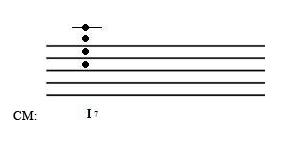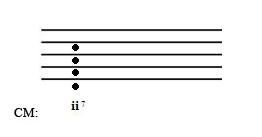Using 7th Chord Voicings to Expand Your Sound And Tone
 Seven, the number of luck. Unfortunately, as we all know, luck has nothing to do with music. There is, however, something very special about seventh chords on the guitar. When you take a triad, move up from the fifth and add a seventh, you get exactly what the name implies; a seventh chord.
Seven, the number of luck. Unfortunately, as we all know, luck has nothing to do with music. There is, however, something very special about seventh chords on the guitar. When you take a triad, move up from the fifth and add a seventh, you get exactly what the name implies; a seventh chord.
As with all chords, the easiest place to start is to use C Major. Together, we will create two common seventh chord voicings; one major and one minor. But first, let’s discuss the qualities of this amazing chord.
The thing that is most appealing about seventh chords is that they all have at least one dissonant interval.
Why Is That So Cool?
Dissonance lends a feeling of instability to the chord, giving the chord a need to resolve. A resolve is a musical term for the need to come to a conclusion. In jazz, the seventh chord is favored for exactly that reason. Seventh chords inevitably lead to the feeling of need for further chords. They are the unofficial book without an ending in the world of music.
Now, time to build our two common seventh chord voicings. We already know that a Major triad is built of a Major third with a minor third tacked on top. For our example, we will be using the tonic to build our Major triad, giving us C, E, G. For people who are confused about building chords, read this article on building basic triads.
For a seventh chord, on top of the fifth, we will stack another Major third. Altogether, we will be moving eleven half steps from the root, which is called a Major seventh. This brings us to B (C#, D, D#, E, F, F#, G, G#, A, A#, B). As with triads, the best way to check your work is to use a diatonic interval, in this case moving a Major seventh from the root.
Your Penned Major Seventh Chord Should Look Like This
 Next up is our minor triad. For this example, we will use the Supertonic of C Major, which is D. Our Supertonic triad is D, F, A. Now, as you may remember, minor triads are built using a minor third with a Major third stacked on top.
Next up is our minor triad. For this example, we will use the Supertonic of C Major, which is D. Our Supertonic triad is D, F, A. Now, as you may remember, minor triads are built using a minor third with a Major third stacked on top.
To create a seventh chord from our Supertonic triad, we would need to move a minor third up from the fifth, bringing us to C (D#, E, F, F#, G, G#, A, A#, B, C). This interval is known as a minor seventh, which is ten half steps from the root.
Here Is How Your Minor 7th Chord Should Look When Tabbed

As you see on both examples, there is a small seven floating in the corner of the scale degree. This small number indicates to the musician that they are playing a seventh chord. It is vital that you remember to always add the seven, as it is the indicator.
With the skills you have learned, creating the other four basic seventh chords from the scale of C Major should be a breeze. The leading tone, however, is a more advanced guitar concept. The seventh scale degree in almost every Major scale is diminished.
I will expand upon the concept further in a future article. For now, try implementing the common seventh chord voicings in your own music. Whether you want to play jazz or rock, the six basic seventh chords have endless possibilities. As always, use the stars as your limit and have fun!
Everything You Need to Become a Great Guitar Player…
For the most comprehensive step-by-step guitar training program, we highly recommend Gibon’s Learn & Master Guitar course. This award winning DVD course is currently having a 3-day sale and you get to save $100 off the usual price today!
Click here to find out more information and get the course before this promotion ends…







Leave A Comment